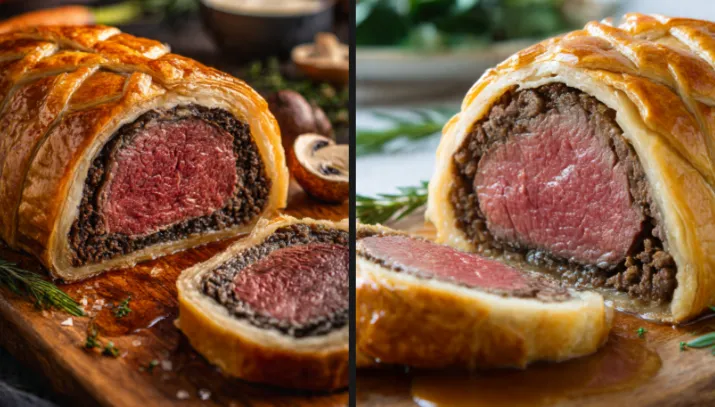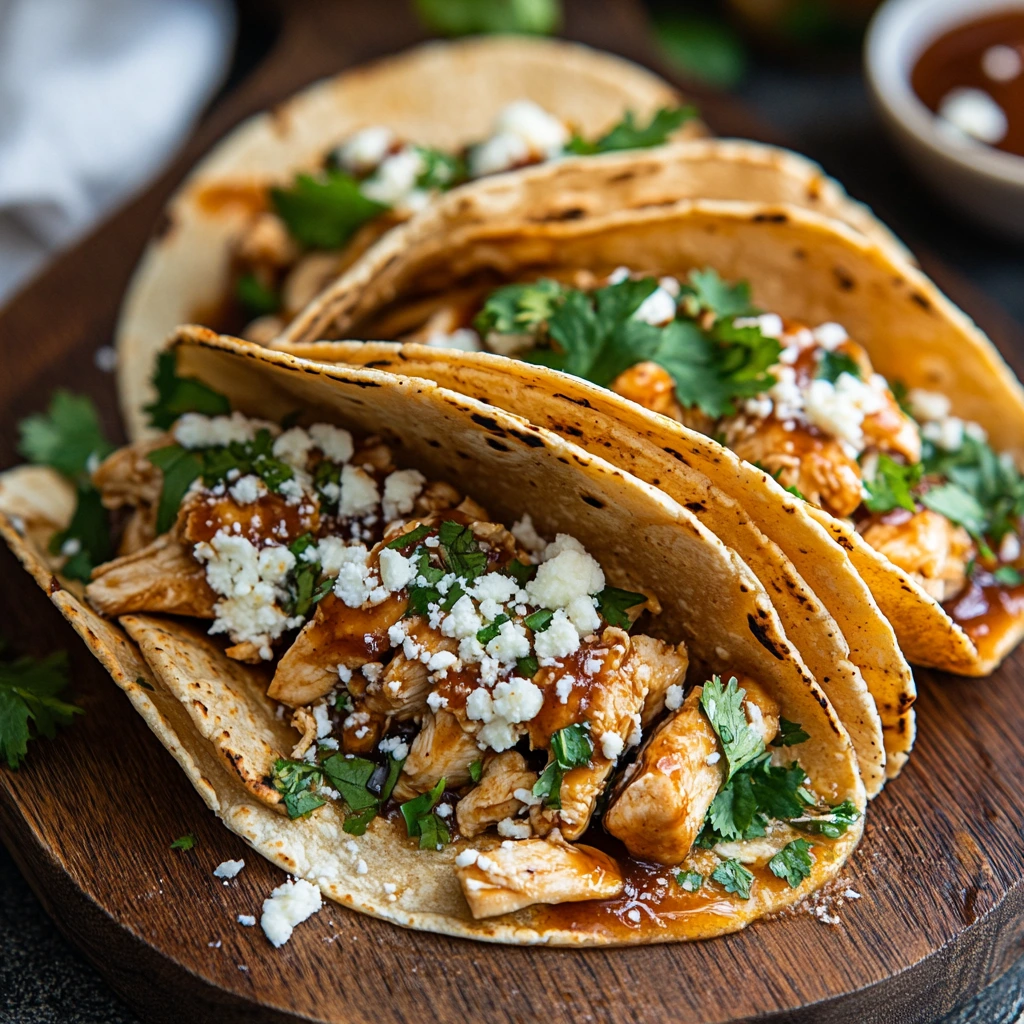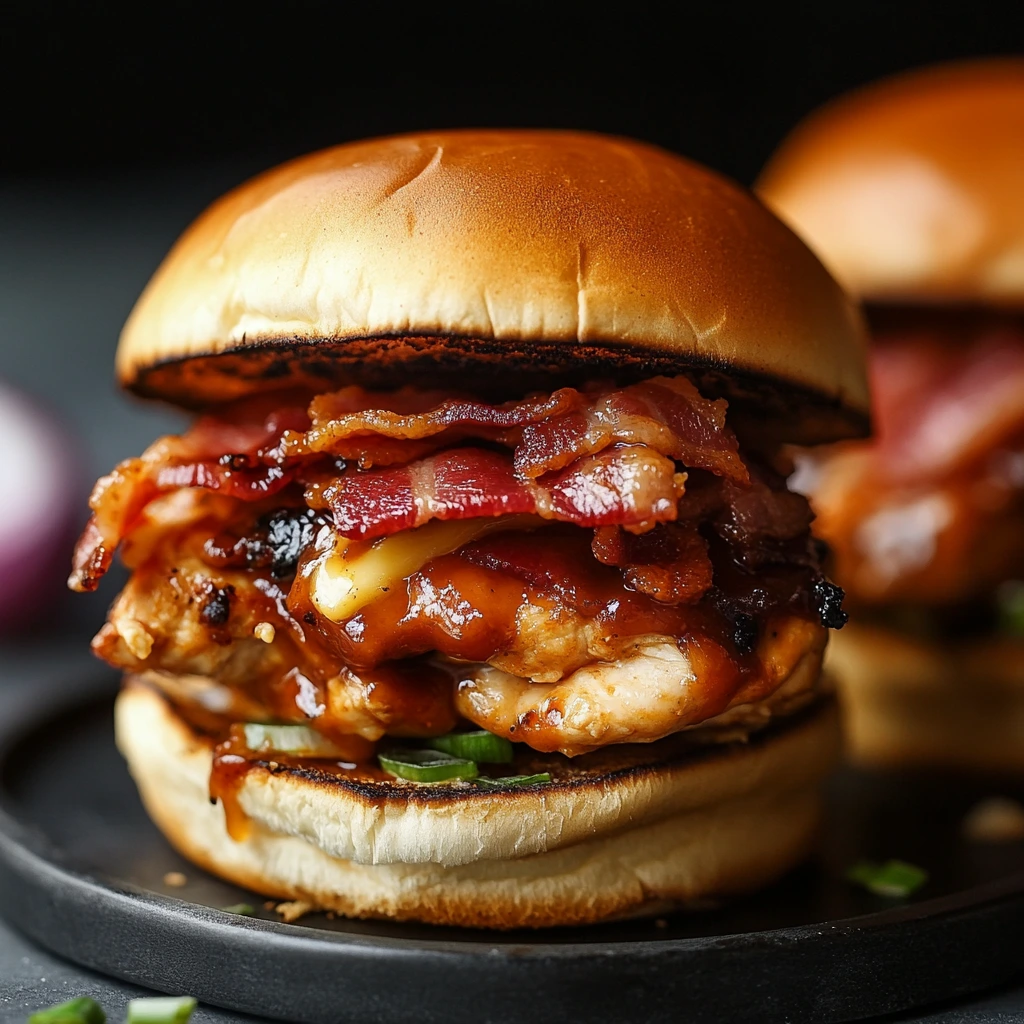Beef Wellington is the epitome of elegance — a tender beef tenderloin wrapped in layers of mushroom duxelles, prosciutto, and golden puff pastry. This dish is a masterpiece of flavor and texture, combining the richness of beef with the earthiness of mushrooms and the buttery crispness of pastry. Perfect for holidays, anniversaries, or any special dinner, Beef Wellington is a culinary showpiece that never fails to impress.
The Essence of Beef Wellington
Beef Wellington is a dish that celebrates precision and indulgence. At its heart lies a perfectly seared beef tenderloin, coated in a finely chopped mushroom mixture known as duxelles, then wrapped in prosciutto and puff pastry. The result is a harmonious blend of flavors — the tender beef contrasts beautifully with the crisp pastry and the savory mushroom filling.
This dish requires care and patience, but the reward is extraordinary: a golden, flaky crust that gives way to juicy, flavorful beef. It’s a dish that embodies both artistry and comfort.
Why Beef Wellington Is So Special
Beef Wellington stands out because it combines multiple textures and flavors in one bite. The beef remains tender and juicy, the mushrooms add depth and umami, and the pastry provides a buttery crunch. The prosciutto layer acts as a barrier, keeping the pastry crisp and preventing moisture from seeping through.
It’s a dish that feels luxurious yet comforting — a perfect balance of refinement and heartiness.
Ingredients and Their Roles
Beef tenderloin (center-cut): The star of the dish, prized for its tenderness and mild flavor.
Mushrooms: Form the duxelles, adding earthy, savory depth.
Shallots and garlic: Enhance the flavor of the mushroom mixture.
Prosciutto: Wraps the beef and prevents the pastry from becoming soggy.
Puff pastry: Encases the beef, creating a golden, flaky crust.
Dijon mustard: Adds tang and helps balance the richness.
Egg yolk: Used for the egg wash to give the pastry a glossy finish.
Thyme: Adds aromatic, herbal notes.
Step-by-Step Recipe for Beef Wellington
Ingredients
- 1 center-cut beef tenderloin (about 2 lbs / 900 g)
- 450 g (1 lb) mushrooms (cremini or button), finely chopped
- 2 shallots, minced
- 2 cloves garlic, minced
- 2 tablespoons unsalted butter
- 2 tablespoons olive oil
- 2 tablespoons Dijon mustard
- 8–10 slices prosciutto
- 1 sheet puff pastry (thawed if frozen)
- 1 egg yolk, beaten with 1 tablespoon water (for egg wash)
- 1 teaspoon fresh thyme leaves
- Salt and pepper to taste
Preparation
1. Prepare the beef
- Season the beef tenderloin generously with salt and pepper.
- Heat olive oil in a heavy skillet over high heat.
- Sear the beef on all sides until browned, about 2–3 minutes per side.
- Remove from the pan and brush with Dijon mustard while still warm.
- Let cool completely.
2. Make the mushroom duxelles
- In the same pan, melt butter and add shallots and garlic. Sauté until fragrant.
- Add finely chopped mushrooms and thyme.
- Cook over medium heat until the mixture is dry and all moisture has evaporated, about 10–12 minutes.
- Season with salt and pepper, then let cool.
3. Assemble the Wellington
- Lay a large piece of plastic wrap on a flat surface.
- Arrange the prosciutto slices in a slightly overlapping layer on the plastic wrap.
- Spread the cooled mushroom duxelles evenly over the prosciutto.
- Place the seared beef on top and use the plastic wrap to roll everything tightly into a log.
- Twist the ends of the plastic wrap to secure and refrigerate for 30 minutes.
4. Wrap in puff pastry
- Roll out the puff pastry on a lightly floured surface into a rectangle large enough to encase the beef.
- Unwrap the beef from the plastic and place it in the center of the pastry.
- Fold the pastry over the beef, sealing the edges with a bit of egg wash.
- Trim any excess pastry and place seam-side down on a parchment-lined baking sheet.
- Brush the entire surface with egg wash.
- Chill for another 15–20 minutes to firm up.
5. Bake the Wellington
- Preheat the oven to 200°C (400°F).
- Brush the pastry again with egg wash and, if desired, score the top lightly with a knife for decoration.
- Bake for 35–40 minutes, or until the pastry is golden brown and the internal temperature of the beef reaches 52°C (125°F) for medium-rare.
- Let rest for 10–15 minutes before slicing.
Tips for Perfect Beef Wellington
- Use dry mushrooms: Excess moisture can make the pastry soggy.
- Cool all components: Prevents steam from softening the pastry.
- Chill before baking: Helps maintain shape and ensures even cooking.
- Use a meat thermometer: Guarantees perfect doneness.
- Rest before slicing: Keeps the juices inside the beef.
Variations to Try
Individual Beef Wellingtons
Make smaller, single-serving versions for elegant dinner parties.
Mushroom-Free Wellington
Replace mushrooms with caramelized onions or spinach for a different flavor.
Truffle Wellington
Add a drizzle of truffle oil or finely chopped truffles to the duxelles for a luxurious twist.
Vegetarian Wellington
Use roasted vegetables and lentils wrapped in puff pastry for a meat-free version.
Red Wine Sauce Wellington
Serve with a rich red wine reduction for added depth.
Serving Suggestions
Beef Wellington pairs beautifully with roasted potatoes, glazed carrots, or green beans almondine. For a festive touch, serve with a red wine jus or creamy peppercorn sauce.
For presentation, slice the Wellington into thick rounds to reveal the layers of beef, mushrooms, and pastry. Garnish with fresh thyme or rosemary sprigs for an elegant finish.
Storage and Make-Ahead Tips
- Make-ahead: Assemble up to 24 hours in advance and refrigerate before baking.
- Freezing: Wrap tightly in plastic and freeze before baking. Bake from frozen, adding 10–15 minutes to the cooking time.
- Leftovers: Store in the refrigerator for up to 3 days. Reheat gently in the oven to maintain crispness.
Nutritional Information (per serving)
- Calories: 650–700 kcal
- Protein: 40 g
- Fat: 45 g
- Carbohydrates: 25 g
- Sodium: 800 mg
The History and Inspiration Behind Beef Wellington
Beef Wellington is believed to have been named after Arthur Wellesley, the first Duke of Wellington, who defeated Napoleon at Waterloo. The dish’s origins are debated, but it likely evolved from French pâté en croûte or filet de bœuf en croûte — beef wrapped in pastry.
Over time, it became a symbol of British fine dining, representing luxury and celebration. Today, it remains a favorite for festive occasions, combining classic European techniques with timeless elegance.
The Texture and Flavor Profile
The perfect Beef Wellington offers a symphony of textures: the crisp, buttery pastry contrasts with the tender, juicy beef, while the mushroom duxelles adds a savory, earthy layer. The prosciutto provides a subtle saltiness that ties everything together.
Each bite delivers richness, depth, and balance — a true culinary masterpiece.
Troubleshooting Common Issues
Soggy pastry: Ensure the mushroom mixture is dry and the beef is cooled before assembly.
Overcooked beef: Use a thermometer and remove the Wellington when it’s 5°C (10°F) below your target temperature.
Pastry splitting: Chill before baking and avoid overhandling.
Uneven browning: Rotate the pan halfway through baking.
Chef’s Tips for Professional Results
- Use high-quality beef tenderloin: The better the cut, the better the result.
- Finely chop mushrooms: A food processor ensures even texture.
- Seal edges tightly: Prevents juices from leaking during baking.
- Brush with egg wash twice: For a deep golden color.
- Let rest before slicing: Keeps the layers intact.
Pairing Ideas
- With Beverages: Pair with Cabernet Sauvignon, Bordeaux, or Pinot Noir.
- With Sides: Serve with mashed potatoes, roasted parsnips, or sautéed spinach.
- With Sauces: Complement with red wine jus, Madeira sauce, or béarnaise.
The Joy of Making Beef Wellington
Preparing Beef Wellington is a labor of love — a dish that rewards patience and precision. From searing the beef to wrapping it in pastry, each step builds anticipation. The aroma of butter and herbs as it bakes fills the kitchen with warmth and excitement.
When sliced at the table, revealing the perfect pink center and golden crust, it becomes more than a meal — it’s a moment of celebration.
The Science Behind the Perfect Wellington
The key to success lies in moisture control and temperature. Searing the beef locks in juices, while the prosciutto and duxelles act as barriers to keep the pastry crisp. The puff pastry expands in the oven, creating delicate, flaky layers that encase the tender beef.
Resting the Wellington after baking allows the juices to redistribute, ensuring every slice is moist and flavorful.
Presentation and Garnishing
For an elegant presentation, serve the Wellington on a wooden board or platter. Slice into thick rounds and arrange neatly. Garnish with fresh thyme, rosemary, or microgreens. A drizzle of red wine sauce or jus adds shine and enhances the visual appeal.
The Perfect Holiday Centerpiece
Beef Wellington is more than a dish — it’s a statement of sophistication and celebration. Its golden crust, tender beef, and rich aroma make it the ultimate showpiece for any festive table. Whether served at Christmas, New Year’s, or a romantic dinner, it embodies the art of fine dining at home.
Conclusion
Beef Wellington is a timeless classic that combines elegance, flavor, and craftsmanship. With its tender beef, savory mushroom duxelles, and golden puff pastry, it’s a dish that transforms any occasion into a feast.
Though it requires care and attention, the result is worth every step — a masterpiece that delights the senses and impresses every guest. Perfectly golden, tender, and full of flavor, Beef Wellington is the ultimate expression of culinary excellence.







